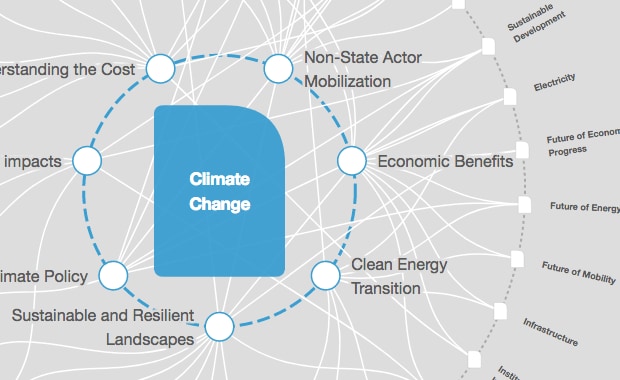Why carbon farming could be the answer to climate change

Carbon farming means to adopt agricultural methods that help in sequestering atmospheric carbon Image: REUTERS/Ilya Naymushin

Get involved with our crowdsourced digital platform to deliver impact at scale
Stay up to date:
Climate Crisis
Under the 2015 Paris Agreement, nations pledged to keep the average global temperature rise to below 2C above pre-industrial levels and to take efforts to narrow that increase to 1.5C. To meet those goals we must not only stop the increase in our greenhouse gas emissions, but we must also draw large amounts of carbon dioxide (CO2) from the atmosphere.
The simplest, most cost-effective and environmentally beneficial way to do this is right under our feet - 'carbon farming'. We can farm carbon by storing it in our agricultural soils.
Soils are traditionally rich in carbon. They can contain as much as five per cent carbon by weight, in the form of soil organic matter — plant and animal matter in various stages of decomposition.
But with carbon farming and the introduction of modern agricultural techniques, including the plow, soil organic matter content has dropped by half in many areas of the world, including parts of Canada. That carbon, once stored in the ground, is now found in the atmosphere and oceans as CO2 and is contributing to global warming.
The organic compounds found in soil are the glue that holds soil particles together and help give the soil structure. Like the walls of a building, this structure creates openings and passageways that allow the soil to conduct and store water, contain air, resist soil erosion and provide a habitat for soil organisms.
Plowing breaks apart soil aggregates and allows microorganisms to eat the soil organic compounds. In the short-term, the increased microbial activity releases nutrients, boosting crop productivity. In the long-term the loss of structure reduces the soil’s ability to hold water and resist erosion. Ultimately, crop productivity drops.
How to start carbon farming?
To farm carbon, first and foremost, we need to disturb soil less. The advent of no-till and reduced tillage methods have allowed us to increase the carbon content of soils.
No-till and direct-seeding methods place the seed directly into the soil, minimizing the disturbance associated with seedbed preparation. The lack of disturbance allows the roots and crop residues from the previous crops to form soil organic matter. It reduces the degradation of the soil organic matter already present in the soil.
In Canada, we are already benefiting from reduced tillage. In the Prairies, no-tillage agriculture has increased from less than five per cent of the land area in the early 1990s to almost 50 per cent in 2006.
The carbon farming situation is a bit more complex in Eastern Canada. The region’s soil type and climate make it less easy to build soil organic matter. At Dalhousie’s Atlantic Soil Health Lab, we are exploring the potential of various cropping practices to increase soil organic matter content in the soils of Atlantic Canada. While the potential to store carbon may not be as great as in Western Canada, the benefits of increased soil organic matter content are far greater because of the critically low levels of organic matter.
Secondly, we can use more diverse crop rotations for carbon farming. Forage crops — such as grasses, clovers and alfalfa — penetrate the soil with extensive root systems that lead to the formation of soil organic matter. Short rotations dominated by crops that have poor root systems (corn, soybeans) are not effective in building soil organic matter.
Farmers can also build soil organic matter by adding organic amendments such as animal manure, composts, forestry residues (wood chips) or biosolids to the soil.
Using the right amount of fertilizer is also important to farm carbon. Fertilizers can improve plant growth, lead to larger roots and add more plant matter to the soil in the unharvested portion of the crop. However, too much nitrogen fertilizer can result in the production of the powerful greenhouse gas nitrous oxide and offset the benefit of increased soil organic matter formation.
Farmers need economic incentives for carbon farming
Project Drawdown, a non-profit organization that researches solutions to global warming, has estimated that global farmland restoration (building soil organic matter) could remove 14 gigatones (billion tonnes) of CO2.
This would reduce the CO2 in the atmosphere below the current 400 parts per million — a level unpassed for several million years — while developing more fertile, resilient soils to feed people for years to come and keep forests intact.
These approaches seem like obvious solutions. Why are they not more widely adopted? The short answer is economics.
The benefits of carbon farming and building soil organic matter play out over decades. But the costs associated with these practices often do not have increased returns in the short term.
Farmers often make decisions in response to short-term economic pressures and government policies. Improved soil management is a public good. We need economic tools and short-term incentives that encourage producers to adopt these carbon farming practices for the good of all.
Don't miss any update on this topic
Create a free account and access your personalized content collection with our latest publications and analyses.
License and Republishing
World Economic Forum articles may be republished in accordance with the Creative Commons Attribution-NonCommercial-NoDerivatives 4.0 International Public License, and in accordance with our Terms of Use.
The views expressed in this article are those of the author alone and not the World Economic Forum.
Related topics:
The Agenda Weekly
A weekly update of the most important issues driving the global agenda
You can unsubscribe at any time using the link in our emails. For more details, review our privacy policy.
More on Climate ActionSee all
Amanda Young and Ginelle Greene-Dewasmes
April 23, 2024
Andrea Willige
April 23, 2024
Agustin Rosello, Anali Bustos, Fernando Morales de Rueda, Jennifer Hong and Paula Sarigumba
April 23, 2024
Carlos Correa
April 22, 2024
Shyam Bishen and Annika Green
April 22, 2024






